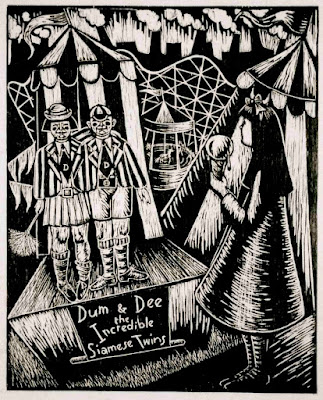Here is a sneak peak at two linocuts in progress. They are part of a long-term project, begun in 2011 at
The Art Vault, that is still very much in its early stages.
Tattooed Woman, 2012 (lino block in progress)
Bearded Lady, 2012 (lino block in progress)
References to carnivals, circuses and sideshows have sporadically appeared in my work, dating way back to childhood scribbles - although thankfully none of these are extant. Doubtless my lifelong fascination with the subject is a direct result of growing up in Blessington Street, St. Kilda, which is walking distance from Luna Park. My recollections of it include the Giggle Palace and all the mind-boggling wonders within (it has long since been destroyed by fire), the River Caves, the stomach-churning Rotor, and an extraordinary ride (dating from around 1908, if memory serves me correctly) that originated in New York’s Coney Island. The exteriors of the latter’s elegant velvet lined carriages were exquisitely hand painted – but the whiplash-inducing ride itself was definitely not for those with delicate constitutions - even by today’s standards.
Although Luna Park had already started the sad, irrevocable process of passing its prime, it still retained much of its former magic. Now, despite the best efforts of its supporters, it’s all rather generic. The magnificent Heritage Listed merry-go-round is the sole survivor from its glory days.
Luna Park, St. Kilda, circa 1960s
In cinema circuses, carnivals and sideshows are frequently sites of chaos and evil, particularly in Film Noir and the Mystery, Thriller and Horror genres. Some notable examples (and some of my personal favourites) include The Cabinet of Doctor Caligari, (dir. Robert Wiene, 1919) Freaks (dir. Tod Browning, 1932) Nightmare Alley (dir. Edmund Goulding, 1947) The Lady from Shanghai (dir. Orson Welles, 1947) and Strangers in a Train (dir. Alfred Hitchcock, 1951.)
The Cabinet of Dr Caligari (dir. Robert Wiene, 1919)
In direct contrast is the touching scene in Hitchcock’s picaresque Saboteur (1942) in which a troupe of circus ‘freaks’ are portrayed with warmth and compassion. It was partly, if not entirely, written by Dorothy Parker. Reportedly Hitchcock was delighted with her contributions to this segment, but believed that at the time of the film’s release its subtleties were lost on most audiences.
Saboteur (dir. Alfred Hitchcock, 1942)
Here are selected examples of carnival and sideshow related images that have featured in my past work. Some may be more familiar than others. The woodcuts from the Alice in the Cities series of the late 1980s have had relatively little exposure. They are the first five images directly below. For those who are familiar with The Cabinet of Dr Caligari, its influence on these works will be more than evident.
1. Thumbing a Lift, 1989, woodcut
2. Dum and Dee, the Incredible Siamese Twins, 1989, woodcut
3. Playing with Fire, 1989, woodcut
4. The Dogs Bark, and the Caravan Moves On, 1989, woodcut
5. The Curtain Descends, Everything Ends, Too Soon, Too Soon, 1989,
woodcut, hand coloured
6. Zelda Fitzgerald and her Psychiatrist, 1991, woodcut
7. See the Lady Sawn in Half! 1996,
linocut (diptych)
8. Lydia the Tattooed Lady, 1995, linocut
9. Kewpie Dolls, 1996, linocut









































